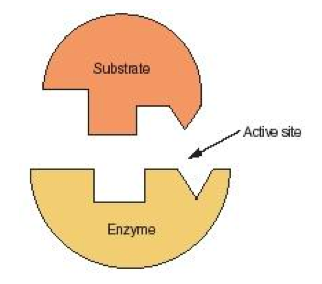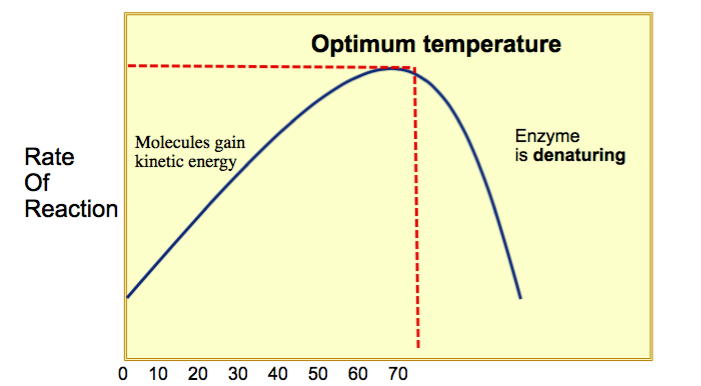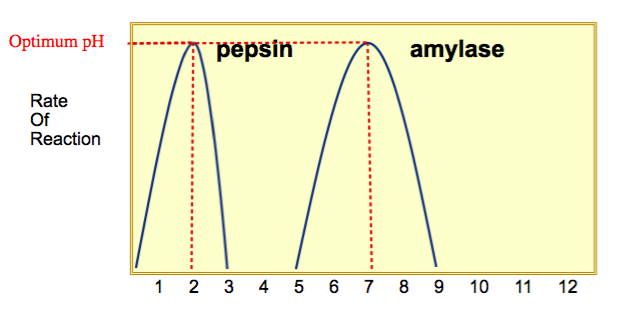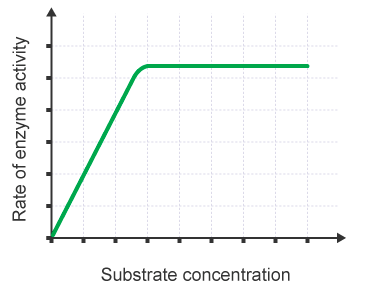Enzymes
Enzyme Action & Specificity
A catalyst__ _is _a substance that speeds up the rate of a chemical reaction but is not itself changed by the reaction.
An enzyme is a biological catalyst that speed up the rate of chemical reaction in cells. Enzymes (and catalysts) take part in a reaction but are __unchanged __at the end of it. They can be used over and over again but are not used up in the reaction.
Here are some examples of useful enzymes:
- Pectinase__ __is used to break down substances in apple cell walls and enable greater juice extraction.
- Lactase__ __breaks down lactose in milk into glucose and galactose. This makes milk drinkable for lactose intolerant people.
Lock and Key Theory
Enzymes have a specific 3D structure. They exactly match the shape of a molecule of substrate.
Steps:
-
Substrate __fits __into active site of enzyme
-
__Reaction __takes place
-
__Products leave __active site, enzyme ready to work again
Denaturation
If the temperature and__ pH__ changes sufficiently beyond an enzyme’s optimum, the shape of the enzyme irreversibly changes. This affects the shape of the active site and means that the enzyme will no longer work. When this happens the enzyme is denatured.
E.g an enzyme may look like this:
But if it becomes denatured, it will look more like this:
The substrate__ will no longer fit in the __active site, therefore no products can be created.
Effects of Temperature, Substrate Concentration ans p H
Factors that affect the rate of a reaction include:
- temperature
- pH
- enzyme concentration
- substrate concentration
- surface area
- pressure
All enzymes work best at only one particular temperature and pH: this is called the optimum. Different enzymes have different optimum temperatures and pH values.
E.g. This graph suggests that the optimum temperature for this enzyme is around 70 degrees.
Temperature (In degrees)
E.g. This graph suggests that the optimum pH for..
Pepsin = 2
Amylase = 7
These are the conditions in which the enzyme would work best in.
Enzymes will work best if there is a lot of available substrate. When the concentration of the substrate increases, the rate of enzyme activity increases too.
However, when an enzyme becomes saturated, no more substrates can fit at any one time even though there is plenty of substrate available. This mean that even when there is a higher substrate concentration, the activity will remain the same as there are not enough enzymes to break down the substrate that is available.
Human Digestive Enzymes
Enzymes work in the digestive system to help us digest food. The break down large indigestible molecules into smaller digestible molecules. They effectively act like scissors cutting up the large molecules.
Without enzymes the larger food molecules would not be absorbed into the body through the lining of the small intestine as they cant pass though. The smaller molecules can and so are taken into the blood.
Energy in Food
The energy contained in food can be measured using calorimetry. In order to calculate the amount of energy that can be found in food, you need to record the initial temperature of water in a boiling tube, burn the food sample under the boiling tube, then measure the final temperature of water.
You will then need to use this formula to calculate the energy transferred to the water with this equation:
energy transferred (J) = mass of water (g) × 4.2 (J/g°C) × temperature increase (°C)
E.g. If 2.5 g of food is burned under the boiling tube, and 15 cm3 of water warms up by 25°C, what is the energy content of the food in J/g?
energy transferred (J) = 15g × 4.2 J/g°C × 25°C = 1575
energy content of food = 1575 ÷ 2.5 = 630 J/g
- In the lock and key model, what does a substrate fit into?
- Active Site
- What is the name of the method that measures the energy contained in food?
- Calorimetry
- What is the enzyme needed to break down proteins into amino acids?
- Protease






